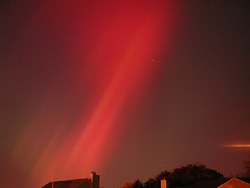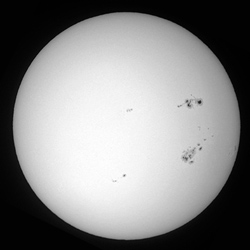
The sky over Boston glowed red early Thursday evening (October 30th), thanks to an impressive aurora display generated by a powerful solar flare. Sky & Telescope editors Imelda B. Joson and Edwin L. Aguirre used a Coolpix 990 digital camera at f/3.5 (ISO 200) and an 8-second exposure to capture this image from their light-polluted driveway northwest of Boston. 'At the peak of the display,' noted Aguirre, 'it was as if the sky was on fire.'
Courtesy Imelda B. Joson and Edwin L. Aguirre.
For the second time in the last few days, a powerful flare on the Sun triggered an unusual display of the aurora borealis over some of the world's midlatitudes. Skywatchers in North America and northern Europe — alerted by news that a major blast of solar wind was barreling into Earth's magnetic field — witnessed luminous displays of red, green, and white in the evening sky after darkness fell Thursday (October 30th).
In the Boston area, home of Sky & Telescope, tall red rays slanted across the sky and changed shape and intensity almost from moment to moment. Sometimes everything vanished for many minutes. Then the rays would return, mingling with green and occasionally converging to a grand corona formation near the zenith.
The chain of events that led to the auroras began with a powerful solar flare in the huge active sunspot region 10486 (also called 486). This is the southernmost of the two giant spots that are currently visible on the Sun's face with the protected naked eye. In fact 486 (lower right in the image below) is the largest sunspot region to appear during this entire 11-year solar cycle. The other group, farther north, is named 488.

This white-light image, acquired on the morning of October 31st, shows the two gigantic naked-eye spot groups heading toward the western (right) limb of the Sun. The double spot is Active Region 10488; the one below it is 10486, which blasted Earth with a coronal mass ejection in the early evening hours of Thursday the 30th. Click on the image for a close view of both sunspots.
Sky & Telescope photo by Gary Seronik.
The flare (rated X11) began at 3:49 p.m. Eastern Standard Time (20:39 UT) on Wednesday the 29th. It spewed a coronal mass ejection (CME) whose leading edge swept past Earth around noon Thursday Eastern Standard Time (17:00 UT), buffeting the Earth's magnetic field and filling it with energetic charged particles. When such particles come streaming down the Earth's magnetic field lines, they make the uppermost regions of the atmosphere fluoresce.
This was the second major solar flare, CME impact, and auroral display in just a few days. An earlier blast of solar wind swept by Earth and lit night skies in the early morning hours of Wednesday, October 29th. That blast also began with a major flare in sunspot 486. Skywatchers as far south as California, New Mexico, Texas, and Florida got grand displays that night.
Severe geomagnetic storms accompanied both events. Large solar flares and geomagnetic storms can disrupt power transmission networks, black out certain radio communications, and cripple satellites temporarily or permanently. There were only scattered reports of ill effects, however.
With the Sun in its most active state since solar maximum two or three years ago, additional flares, CMEs, geomagnetic disturbances, and auroras remain possible for the next several days, until the two big spots rotate westward to the Sun's limb and point well away from Earth.
The two naked-eye spots are actually the second and third to appear during the current spot outbreak, which began on October 18th. The first, 484, has rotated out of view around the Sun's western limb but was an easy sunspot to view without optical aid.
Remember, never look at the Sun without proper eye protection. There are a variety of ways to safely observe the Sun, many of which can be found in the solar observing section of SkyandTelescope.com.
To get e-mail alerts of solar flares, CMEs, and possible auroras, subscribe to Sky & Telescope's AstroAlert for solar activity.
Sunspots are relatively cool regions in the Sun's photosphere (visible surface). They form where solar magnetic fields lock onto the Sun's churning ionized gas and hold it in place long enough to cool. The photosphere's average temperature is 5,700° Kelvin, but in a sunspot's dark center (umbra), where the field is strongest, it's about 2,000°K cooler. If you could view a sunspot by itself, it would appear blazingly bright. It appears dark only in contrast with its even brighter surroundings. The umbra of a spot is typically surrounded by a lighter penumbra, where the magnetic field allows the gas more motion.
You can view the latest solar images from the SOHO spacecraft (click on "Latest Images," then "Near real time images)." Also check out SOHO's MPEG movies of spots and coronal mass ejections, and SpaceWeather.com's Aurora Gallery of photographs.
 0
0









Comments
You must be logged in to post a comment.